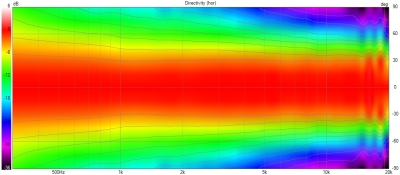PressureWave: Defying High Frequency Directivity Thanks to Wavefront Compression
PressureWave
PressureWave technology introduces a new approach to tackling high-frequency dispersion. It employs a unique technique called wavefront compression.
By strategically compressing the wavefront of the sound wave, PressureWave allows for effective interaction with the entire horn profile even for very high frequencies. This translates to precise control of the top end frequency spectrum, which can be beneficial depending on the horn’s intended application.
Essentially, this compression modifies the wave’s behavior, making it more susceptible to shaping by and follow the horn geometry when the wavelength is smaller than the throat diameter.
PressureWave achieves constant directivity control even for very high frequencies, complementing, not replacing, modern fluid pinch designs when necessary.
Breaking the Throat Diameter Rule
Traditionally, horn design relies on a well-established principle, here simplified:

The throat diameter dictates the level of control over high-frequency directivity:
When the frequency wavelength is inferior to throat diameter or pinch distance it’s the natural directivity of the throat exit that will dictates directivity, according to his surface.
However, PressureWave technology disrupts this established rule by employing wavefront compression without adding or use diffraction, PressureWave horns achieve excellent high frequency directivity even with a big throat.
This opens up possibilities for speaker design, especially big horns in cinemas with bleachers seating as seen in M-Shape horns, we can see the constant behavior keeped on all the bandwidth:
Of course the chaotic nature of the wavefront in very high frequency is still visible very high: When the diaphragm’s breakup occurs it exits plane-wave radiation behavior, but this time, instead of doing a hollow, it stays constant.
Addressing the Chaotic Nature
While PressureWave offers a new approach, it’s not without its complexities.
Compressing the wavefront can introduce chaotic behavior in the sound radiation pattern if the horn shape isn’t meticulously designed and rigorously simulated.
Using Pressure Wave is possible only in some case with precise conditions, depending of the horn but also to the objective given to the horn.
To harness the full potential of PressureWave, speaker designers utilize advanced computational simulations and precise engineering practices. These ensure the creation of horn profiles that achieve optimal control over the entire audio spectrum, delivering the intended directivity and optimum wavefront propagation.
Conclusion

PressureWave technology represents a significant advancement in overcoming high-frequency dispersion in long range big throat horns - after 1" diameter.
It not work alone or in replacement of something else, a result in directivity behavior is the consequence of several factors.
By strategically manipulating the wavefront, PressureWave horns defy the limitations of traditional designs.
